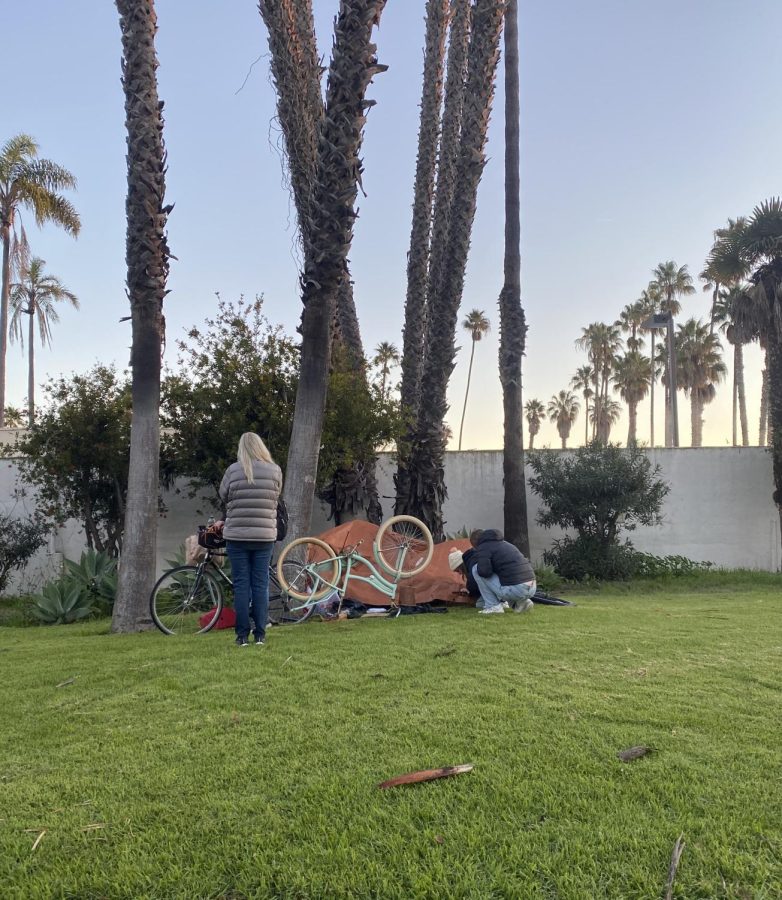“Living on the streets” – Why We Need to Change the Way We View Homelessness
My personal experience of volunteering for the 2023 Santa Barbara Point-in-Time Count
May 24, 2023
On Thursday, January 25th, 2023, I participated in the annual Santa Barbara Point-in-Time Count. This effort wholly altered my perspective on the experiences of the “homeless” community in my home city of Santa Barbara.
Walking the streets adjacent to the waterfront in the morning dark, our group bundled up under ski jackets and knit gloves. Still, the cold air made us shiver. The first man we encountered, Richard, was sleeping by the side of the train tracks. He was protecting himself from the cold with his sleeping bag. It was 6 am, and the train station was shrouded in darkness.
One of our team members approached Richard and began talking to him about the survey. Besides simply counting the number of individuals living on the streets, the Point-in-Time Count seeks to build further understanding between those without housing and those with housing through a series of optional survey questions.
The rest of us, who were still nervous about the concept of going up to a stranger lying in the dark and waking them in the early hours of the morning, watched on in admiration. Watching one of our team members crouch down, talk to someone, and cross the train tracks to make the extra effort to reach out, moved me. We gifted Richard with one of the care packages we were carrying and a new flashlight. His gratitude motivated the members of our team who were still skeptical about taking the initiative to march onward, reaching new connections with kind strangers like Richard.
Next along our route, we encountered a man, a father sleeping behind a mattress on the sidewalk. Each body lying down- sheltered by blankets and shivering in the cold seemed to have a brilliant story. Sometimes the stories were of glory days passed, what was eaten for breakfast yesterday, or what may lie ahead. No matter what the story is, it is vital that we listen.
In order to recognize the rampant homelessness in our community (1,887 individuals, according to the results of the count), we must begin to see these sleeping bags, blankets, and flipped-over mattresses as people.
People living on the streets spend their nights in the cold, the same cold that bit our skin, even layered in hoodies and beanies. The cold experienced by our group for 4 hours that morning is the cold that those without permanent housing must survive every night. One thousand eight hundred eighty-seven members of our community spend each night without the comfort of knowing where they will spend the next night, if they will be able to sleep through the night, or if they will be able to live through the night.
As the hours passed, the morning light rose, more nerves arose, and my friends and I gathered our courage. Reaching out was a difficult feeling to wrestle with and a massive step outside of my comfort zone. Often we assume that people would rather be left alone and would not react kindly to questions from a stranger.
We next approached a man on a mission, loading his bike up for his commute next to a tent structure fashioned from a tarp. This man, our group now refers to him as Biker- was quite the character.
The most memorable part of my interaction with Biker was his rejection of the term “homeless.”
When we hear the term homeless, a major conversation is around political correctness. Before participating in the Point-in-Time count, I didn’t understand the difference between not having permanent shelter and being “homeless.” The reality is that the people we have chosen to see as outsiders or trespassers have homes; their homes just look differently than we expect them to.
Isn’t the sidewalk the father lays down on, behind the mattress stacked at a 90-degree angle for privacy, a home? We all have to sleep somewhere.
When I asked Biker how long he had been “homeless,” he balked. “I’m not homeless,” he insisted, “I just am living on the streets.” He gestured to the tarp behind him, strung up with his friend asleep inside, “This is my home. It just happens to be on the streets.”
Biker’s home is a tarp tent on the frostbitten grass next to a lone palm tree. It is where his belongings are, where he lays his head each night to sleep, where he lives with his friend, and where he leaves each morning on his bike.
To truly understand homelessness, we must concede that a tarp is a home; it just happens to be on the streets.
Our Santa Barbara population living on the streets is not really homeless, as they are still members of our community. Our community should include all people who call Santa Barbara home, even if that home is on the streets.
No community member should be valued more or less than another because of their housing status. The individuals that I met in January: Richard, the father, Biker, and more, were some of the kindest, most insightful, and most considerate individuals I have interacted with to this day.
Interactions with those living on the streets, such as the opportunities presented by Point-in-Time Count, can remind us that we are all a community, no matter our individual circumstances. Some of our homes just happen to be on the streets. To finish, I will quote Tracy Kidder, an acclaimed author on the issue of homelessness, who I heard speak in March, “Once you see homeless people as people, you become enraged with the issue and see that it needs to be resolved.”
If we continue to prioritize conversations between the housed and the un-housed, a further understanding could pave the way for a future where every community member can tell their story.


































